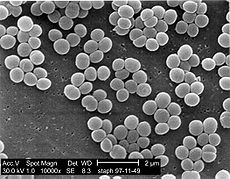- Staphylococcal infection
-
Staphylococcal infection Classification and external resources 
SEM micrograph of S. aureus colonies; note the grape-like clustering common to Staphylococcus species.MeSH C013203 Staphylococcus is a genus of Gram-positive bacteria which includes several species that can cause a wide variety of infections in humans and other animals through either toxin production or invasion.
Staphylococcal toxins are a common cause of food poisoning, as they can be produced in improperly-stored food.
Contents
Coagulase-positive
Further information: Staphylococcus aureus#Role in diseaseThe main coagulase-positive staphylococcus is Staphylococcus aureus.
These bacteria can survive on dry surfaces, increasing the chance of transmission. S. aureus is also implicated in toxic shock syndrome; during the 1980s some tampons allowed the rapid growth of S. aureus, which released toxins that were absorbed into the bloodstream. Any S. aureus infection can cause the staphylococcal scalded skin syndrome, a cutaneous reaction to exotoxin absorbed into the bloodstream. It can also cause a type of septicaemia called pyaemia. The infection can be life-threatening. Problematically, Methicillin-resistant Staphylococcus aureus (MRSA) has become a major cause of hospital-acquired infections, and is being recognized with increasing frequency in community-acquired infections.
Etymology
The generic name Staphylococcus is derived from the Greek word "staphyle" meaning a bunch of grapes, and "kokkos" means berries. The bacteria, when seen under a microscope appear like a branch of grapes or berries.
Main Staphylococcus aureus infections Type Examples Localized skin infections - Stye and other small, superficial abscesses in sweat or sebaceous glands
- Subcutaneous abscesses (boils) around foreign bodies
- Large, deep, infections (carbuncles) possibly causing bacteremia
Diffuse skin infection
Deep, localized infections
- Acute and chronic osteomyelitis
- Septic arthritis
Other infections
- Acute infective endocarditis
- Septicemia
- Necrotizing pneumonia
Toxinoses
Unless else specified in boxes, then reference is [1] Other infections include:
- Closed-space infections of the fingertips, known as paronychia.
Capitalization
As with all genus (generic) names in binomial nomenclature, Staphylococcus is capitalized when used alone or with the species. It is also properly italicized. However, it is not capitalized or italicized when used in adjectival forms (as in a staphylococcal infection), or as the plural (staphylococci or when writing of one of several types of staphylococcus).[2]
Coagulase-negative
- S. epidermidis, a coagulase-negative staphylococcus species, is a commensal of the skin, but can cause severe infections in immune-suppressed patients and those with central venous catheters.
- S. saprophyticus, another coagulase-negative species that is part of the normal vaginal flora, is predominantly implicated in genitourinary tract infections in sexually-active young women.
- In recent years, several other staphylococcal species have been implicated in human infections, notably S. lugdunensis, S. schleiferi, and S. caprae.
References
- ^ Page 349 in: Fisher, Bruce; Harvey, Richard P.; Champe, Pamela C.. Lippincott's Illustrated Reviews: Microbiology (Lippincott's Illustrated Reviews Series). Hagerstown, MD: Lippincott Williams & Wilkins. ISBN 0-7817-8215-5.
- ^ See genus and species capitalization.
Firmicutes (low-G+C) Infectious diseases · Bacterial diseases: G+ (primarily A00–A79, 001–041, 080–109) Bacilli Streptococcusαoptochin susceptible: S. pneumoniae (Pneumococcal infection)optochin resistant: S. viridans: S. mitis, S. mutans, S. oralis, S. sanguinis, S. sobrinus, milleri groupβA, bacitracin susceptible: S. pyogenes (Scarlet fever, Erysipelas, Rheumatic fever, Streptococcal pharyngitis)B, bacitracin resistant, CAMP test+: S. agalactiaeungrouped: Streptococcus iniae (Cutaneous Streptococcus iniae infection)StaphylococcusClostridia Clostridium (spore-forming)Peptostreptococcus (non-spore forming)Peptostreptococcus magnusMollicutes MycoplasmataceaeUreaplasma urealyticum (Ureaplasma infection) · Mycoplasma genitalium · Mycoplasma pneumoniae (Mycoplasma pneumonia)Erysipelothrix rhusiopathiae (Erysipeloid)Dermatitis and eczema (L20–L30, 690–693,698) Atopic dermatitis Besnier's prurigoSeborrheic dermatitis Pityriasis simplex capillitii · Cradle capContact dermatitis
(allergic, irritant)other: Abietic acid dermatitis · Diaper rash · Airbag dermatitis · Baboon syndrome · Contact stomatitis · Protein contact dermatitisEczema Autoimmune estrogen dermatitis · Autoimmune progesterone dermatitisBreast eczema · Ear eczema · Eyelid dermatitis · Hand eczema (Chronic vesiculobullous hand eczema, Hyperkeratotic hand dermatitis)Autosensitization dermatitis/Id reaction (Candidid, Dermatophytid, Molluscum dermatitis) · Circumostomy eczema · Dyshidrosis · Juvenile plantar dermatosis · Nummular eczema · Nutritional deficiency eczema · Sulzberger–Garbe syndrome · Xerotic eczemaPruritus/Itch/
PrurigoDrug-induced pruritus (Hydroxyethyl starch-induced pruritus) · Senile pruritus · Aquagenic pruritus (Aquadynia)Adult blaschkitis · due to liver disease (Biliary pruritus · Cholestatic pruritus) · Prion pruritus · Prurigo pigmentosa · Prurigo simplex · Puncta pruritica · Uremic pruritusOther/ungrouped substances taken internally: Bromoderma · Fixed drug reactionCategories:
Wikimedia Foundation. 2010.
